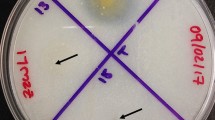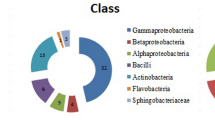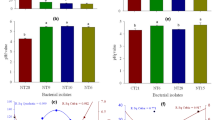Abstract
Several processes that promote plant growth were investigated in endophytic and symbiotic bacteria isolated from cowpea and siratro nodules and also in bacterial strains recommended for the inoculation of cowpea beans. The processes verified in 31 strains were: antagonism against phytopathogenic fungi, free-living biological nitrogen fixation, solubilization of insoluble phosphates and indole acetic acid (IAA) production. The resistance to antibiotics was also assessed. Sequencing of the partial 16S rRNA gene was performed and the strains were identified as belonging to different genera. Eight strains, including some identified as Burkholderia fungorum, fixed nitrogen in the free-living state. Eighteen strains exhibited potential to solubilize calcium phosphate, and 13 strains could solubilize aluminum phosphate. High levels of IAA production were recorded with l-tryptophan addition for the strain UFLA04-321 (42.3 μg mL−1). Strains highly efficient in symbiosis with cowpea bean, including strains already approved as inoculants showed the ability to perform other processes that promote plant growth. Besides, these strains exhibited resistance to several antibiotics. The ability of the nitrogen-fixing bacteria to perform other processes and their adaptation to environmental conditions add value to these strains, which could lead to improved inoculants for plant growth and environmental quality.

Similar content being viewed by others
References
Antoun H, Beauchamp CJ, Goussard N, Chabot R, Lalande R (1998) Potencial of Rhizobium and Bradyrhizobium species as plant growth promoting rhizobacteria on non-legumes: effect on radishes (Raphanus sativus L.). Plant Soil 204:57–67
Asghar HN, Zahir ZA, Arshad M, Khaliq A (2002) Relationship between in vitro production of auxins by rhizobacteria and their growth-promoting activities in Brassica juncea L. Biol Fertil Soils 35:231–237
Berraquero FR, Baya AM, Cormenzana AR (1976) Establishment of índices for the study of phosphate solubilization by soil bacteria. Ars Pharm 17:399–406
Biswas JC, Ladha JK, Dazzo FB, Yanni YG, Rolfe BG (2000) Rhizobial inoculation influences seedling vigor and yield of rice. Agron J 92:880–888
Boeiro L, Perrig D, Masciarelli O, Penna C, Cassán F, Luna V (2007) Phytohormone production by three strains of Bradyrhizobium japonicum and possible physiological and techonological implications. Appl Microbiol Biotechnol 74:874–880
Caballero-Mellado J, Martinez-Aguilar L, Paredes-Valdez G, Estrada De Los Santos P (2004) Burkholderia unamae sp. nov., in N2-fixing rhizospheric and endophy species. Int J Syst Evol Microbiol 54:1165–1172
Chabot R, Beauchamp CJ, Kloepper JW, Antoun H (1996) Growth promotion of maize and lettuce by phosphate-solubilizing Rhizobium leguminosarum biovar phaseoli. Plant Soil 184:311–321
Collavino MM, Sansberro PA, Mroginski LA, Aguilar OM (2010) Comparison of in vitro solubilization activity of diverse phosphate-solubilizing bacteria native to acid soil and their ability to promote Phaseolus vulgares growth. Biol Fertil Soils 46:727–738
Dreyfus BL, Elmerich C, Dommergues YR (1983) Free-living rhizobium strain able to grow on N2 as the sole nitrogen source. Appl Environ Microbiol 45:711–713
Dreyfus B, Garcia JL, Gillis M (1988) Characterization of Azorhizobium caulinodans gen.nov, sp.nov, a stem-nodulating nitrogen-fixing bacterium isolated from Sesbania rostrata. Int J Syst Bacteriol 38:89–98
Elliott NG, Chen WM, Jui-Hsing C, Shih-Yi S, Perin L, Reis VM (2007) Burkholderia phymatum is a highly effective nitrogen-fixing symbiont of Mimosa spp. and fixes nitrogen ex plant. New Phytol 173:168–180
Ferreira DF (2008) Sisvar: a program for statistical analysis and teaching. Revista Symp 6:36–41
Ferreira PAA, Bomfeti CA, Soares BL, Moreira FMS (2012) Efficient nitrogen-fixing Rhizobium strains isolated from amazonian soils are highly tolerant to acidity and aluminium. World J Microbiol Biotechnol 28:1947–1959
Florentino LA, Jaramillo PMD, Silva KB, Silva JS, Oliveira SM, Moreira FMS (2012) Physiological and symbiotic diversity of Cupriavidus necator strains isolated from nodules of Leguminosae species. Sci Agric 69:247–258
Fred EB, Waksman SA (1928) Laboratory manual of general microbiology. McGraw-Hill Book, New York
Hara FAZ, Oliveira LA (2004) Physiological and ecological characteristics of rhizobia isolates deriving of acid and alic soils of Presidente Figueiredo, Amazonas State. Acta Amazônica 34:343–357
Ikeda AC, Bassani LL, Adamoski D, Stringari D, Cordeiro VK, Glienke C, Steffens MBR, Hungria M, Galli-Terasawa LV (2013) Morphological and genetic characterization of endophytic bacteria isolated from roots of different maize genotypes. Microb Ecol 65:154–160
Lacerda AM, Moreira FMS, Andrade MJB, Soares ALL (2004) Yield and nodulations of cowpea inoculated with selected rhizobia strains. Revista Ceres 51:67–82
Lane DJ (1991) 16S/23S rRNA sequencing. In: Stackebrandt E, Goodfellow M (eds) Nucleic acid techniques in bacterial systematics. Wiley, New York, USA, pp 115–148
Lugtenberg BJJ, Kamilova F (2009) Plant-growth-promoting rhizobacteria. Annu Rev Microbiol 63:541–556
Marra LM, Oliveira SM, Soares CRF, Moreira FMS (2011) Solubilisation of inorganic phosphates by inoculant strains from tropical legumes. Sci Agric 68:603–609
Martins LMV, Xavier GR, Rangel FW, Ribeiro JRA, Neves MCP, Morgado LB, Rumjanek NG (2003) Contribution of biological nitrogen fixation to cowpea: a strategy for improving grain yield in the Semi-Arid Region of Brazil. Biol Fertil Soils 38:333–339
Monteiro JM, Vollú RE, Coelho MRR, Alvino CS, Blank AF, Seldin L (2009) Comparison of the bacterial community and characterization of plant growth promoting rhizobacteria from different genotypes of Chrysopogon zizanioides (L.) Roberty (Vetiver) Rhizospheres. J Microbiol 47:363–370
Moreira FMS, Cruz L, Faria SM, Marsh T, Martinez-Romero E, Pedrosa FO, Pitard RM, Young JPW (2006) Azorhizobium doebereiner sp. Nov. Microsymbiont of Sesbania virgata (Caz.) Pers. Syst Appl Microbiol 29:197–206
Ogut M, Er F, Kandemir N (2010) Phosphate solubilization potentials of soil Acinetobacter strains. Biol Fertil Soils 46:707–715
Oliveira-Longatti SM, Marra LM, Moreira FMS (2013) Evaluation of plant growth-promoting traits of Burkholderia and Rhizobium strains isolated from Amazon soils for their co-inoculation in common bean. Afr J Microbiol Res 7:948–959
Peix A, Rivas-Boyero AA, Mateos PF, Rodriguez-Barrueco C, Martínez-Molina E, Velazquez E (2001a) Growth promotion of chickpea and barley by a phosphate solubilizing strain of Mesorhizobium mediterraneum under growth chamber conditions. Soil Biol Biochem 33:103–111
Peix A, Rodriguez-Barrueco C, Martinez-Molina E, Velazquez E (2001b) Growth promotion of common bean (Pasheolus vulgaris L.) by a strain of Burkholderia cepacia under growth chamber conditions. Soil Biol Biochem 33:1927–1935
Radwan T, Mohamed ZK, Reis VM (2002) Production of indole-3-acetic acid by different strains of Azospirillum and Herbaspirillum spp. Symbiosis 31:39–54
Sarwar M, Kremer RJ (1995) Enhanced suppression of plant growth through production of l-tryptophan-derived compounds by deleterious rhizobacteria. Plant Soil 172:261–269
Schlindwein G, Vargas LK, Lisboa BB, Azambuja AC, Granada CE, Gabiatti NC (2008) Influence of rhizobial inoculation on seedling vigor and germination of lettuce. Ciênc Rural 38:658–664
Silva K, Cassetari AS, Lima AS, Brandt ED, Pinnockd E, Vandamme P, Moreira FMS (2012) Diazotrophic Burkholderia species isolated from the Amazon region exhibit phenotypical, functional and genetic diversity. Syst Appl Microbiol 35:253–262
Soares ALL, Pereira JPR, Ferreira PAA, Vale HMM, Lima AS, Andrade MJB (2006) Agronomic efficiency of selected rhizobia strains and diversity of native nodulating populations in Perdões (MG-Brazil). Rev Bras Ciênc Solo 30:795–802
Spaepen S, Vanderleyden J, Remans R (2007) Indole-3-acetic acid in microbial and microorganism-plant signaling. FEMS Microbiol Rev 31:425–448
Sylvester-Bradley R, Asakawa N, La Torraca S, Magalhães FMM, Oliveira LA, Pereira RM (1982) Quantitative survey of phosphate solubilizing microorganisms in the rhizosphere of grasses and legumes in the Amazon. Acta Amazônica 12:15–22
Tarrand JJ, Krieg NR, Dobereiner J (1978) A taxonomic study of the Spirillum lipoferum group with description of a new genus, Azospirillum gen. nov. and two species, Azospirillum lipoferum (Beijerinck) com. nov. and Azospirillum brasilense sp. nov. Can J Microbiol 24:967–980
Theunis M, Kobayashi H, Broughton WJ, Prinsen E (2004) Flavonoids, NodD1, NodD2, and nod-box NB15 modulate expression of the y4wEFG locus that is required for indole-3-acetic acid synthesis in Rhizobium sp. strain NGR234. Mol Plant Microbe 17:1153–1161
Vandamme P, Goris J, Chen WN, Vos P, Willems A (2002) Burkholderia tuberum sp. nov. and Burkholderia phymatum sp. nov., nodulate the roots of tropical legumes. Syst Appl Microbiol 25:507–512
Acknowledgments
We thank Capes and Fapemig for student fellowships, CNPq for research fellowship and grant, and project GEF/UNEP-GF2715-02 (CSM-BGBD) for financial support. This publication presents part of the findings of the international project “Conservation and Management of Below-Ground Biodiversity” implemented in seven tropical countries—Brazil, Cote d’Ivoire, India, Indonesia, Kenya, Mexico, and Uganda. This project is coordinated by the Tropical Soil Biology and Fertility Institute of CIAT (TSBF-CIAT with co-financing from the Global Environmental Facility (GEF), and implementation support from the United Nations Environment Program (UNEP). Universidade Federal de Lavras was the Brazilian executing institution.
Author information
Authors and Affiliations
Corresponding author
Rights and permissions
About this article
Cite this article
de Oliveira-Longatti, S.M., Marra, L.M., Lima Soares, B. et al. Bacteria isolated from soils of the western Amazon and from rehabilitated bauxite-mining areas have potential as plant growth promoters. World J Microbiol Biotechnol 30, 1239–1250 (2014). https://doi.org/10.1007/s11274-013-1547-2
Received:
Accepted:
Published:
Issue Date:
DOI: https://doi.org/10.1007/s11274-013-1547-2




